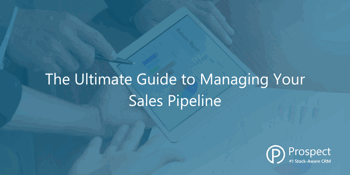
The Ultimate Guide to Managing Your Sales Pipeline
Facing rejection during the sales process is a natural defeat that anyone in the world of B2B is familiar with. But when your business becomes too comfortable with defeat, it’s important that you have a structure in place that aims to pre-empt and avoid the issue. So, we’ve put together the ultimate guide to building and managing a sales pipeline that prospers every time.
B2B selling is heavily reliant upon the customer base that you generate as well as the relationship you establish with them, and a lot of this depends upon just the first few interactions you have with prospects during the sales process. Your sales pipeline should not only aim to steer your prospects from point A to point B, but should guide them through the sales funnel in a way that’s simple to navigate and nourishes their interest in your products.
What is a sales pipeline and why is it important?
To put it simply, a sales pipeline is a defined series of phases that fill the gap between lead and sale. For your customer-facing teams, pipelines assist in managing every sale in an efficient, logical manner. There are some standard stages that all B2B product sellers should implement in their sales process, but the best sales pipelines adapt to your buyer’s journey and the style of relationship you build with your prospects and customers.
Defining a sales pipeline that procures a high success rate is a matter of trial and error. Although there are some conventional strategies that have been proven to work, every customer base is different and requires varying measures of contact to guarantee the sale. Ultimately, it’s never going to be perfect first time, so iteration is key. Getting your whole team to stick to it, then moulding them based on what works, and what doesn’t, will make for an improved process. But without a clearly defined sales process in place, how can you identify what needs changing if a sale falls through?
Building & managing your sales pipeline
While a templated sales process won’t work for every business, here are a few key stages to include in and adapt to fit your pipeline:
- Attracting leads/lead generation: Identifying and contacting potential customers that seem like a good fit, getting the deal underway.
- Lead qualification: Evaluating whether the leads you’ve generated actually fit your ideal customer profile ( ICP). Prioritising lead qualification early in the sales pipeline mitigates any time wasted in the long run.
- Meeting/send samples: Now is the time to pitch your product by conducting a sales call, meeting them in person, or sending samples. It’s also the perfect time to build and anchor your relationship with prospects so they develop an affinity for not only your products, but your services as well.
- Quote: Usually at this stage, the buyer will request a quote and a proposal will be sent to finalise the deal.
- Negotiation: This is where the final price is agreed and the relationship between buyer and seller is formed.
- Closed: You can now mark this opportunity as a win or a loss, but the sale doesn’t end here.
- Onboard: As a B2B product seller, the first order to a new customer may be sold at cost, or even at a loss. Work towards securing the first 4 orders to successfully onboard them, turning them into a relational buyer.
- Retention: Post-purchase interaction is fundamental to sustaining your customer’s lifetime value. From optimising your quote-to-order workflow to identifying upsell and cross-sell opportunities to increase average order values and frequency of orders - there are plenty of ways you can drive and maintain customer loyalty during the after-sale stage.
Ensuring your sales pipeline leads to a win doesn’t just rely on having a standardised pipeline in place - it also depends upon the frequency and quality of engagement along the line. During negotiation, for example, it’s important not to let contact desist just because you’re waiting for a decision. While you don’t want to overwhelm your buyers with a flooding of emails to their inbox, it won’t go amiss to check in with their progress and offer further support at appropriate intervals.
Introducing automation to your pipeline can tighten the string that connects lead and sale, and ensures the process doesn’t lose momentum. CRM helps with the tracking and logging of communication with buyers as well as the pipeline status, making certain that your Sales team is engaging with your prospects at the right time. For product businesses, a CRM that integrates with your Inventory Management/ERP system should give your team greater stock visibility, and allow them to report on opportunities by product and customer for end-to-end reporting.
Ultimately, your sales pipeline should align with your customer journey, utilise automation to streamline the process, and reinforce relationships. Without these fundamental considerations, it’s likely that you’ll see your conversion rates wane and you won’t be able to identify where the issue lies. However, with a the right workflows in place, your product business should take more orders in less time to achieve profitable sales growth.
Want to transform your sales pipeline? Prospect CRM helps B2B product businesses automate all aspects of a sales motion, ensuring their pipeline is geared for success. When you sign up to our 14-day free trial, configuring your sales pipeline with the expert advice from our Onboarding team is where profitable business growth begins.
